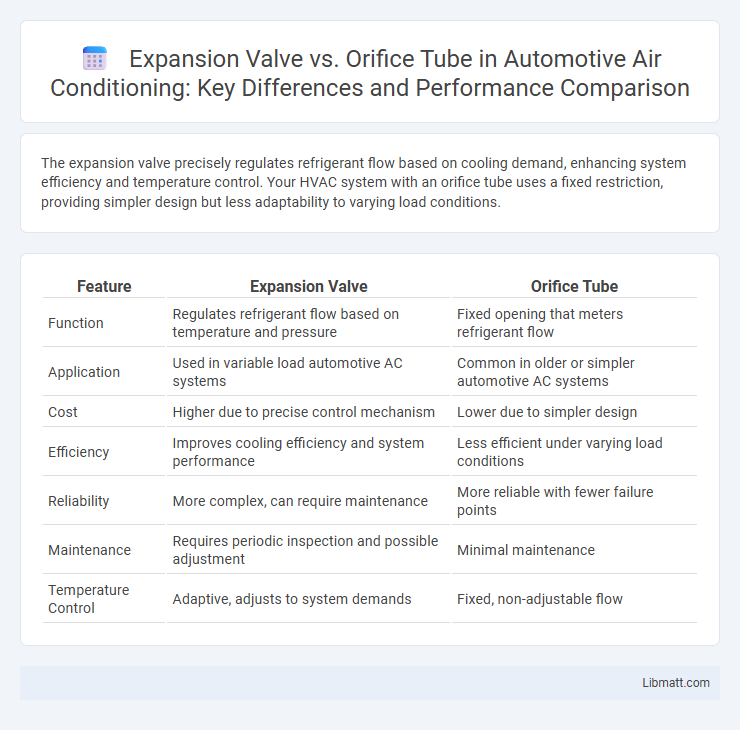The expansion valve precisely regulates refrigerant flow based on cooling demand, enhancing system efficiency and temperature control. Your HVAC system with an orifice tube uses a fixed restriction, providing simpler design but less adaptability to varying load conditions.
Table of Comparison
| Feature | Expansion Valve | Orifice Tube |
|---|---|---|
| Function | Regulates refrigerant flow based on temperature and pressure | Fixed opening that meters refrigerant flow |
| Application | Used in variable load automotive AC systems | Common in older or simpler automotive AC systems |
| Cost | Higher due to precise control mechanism | Lower due to simpler design |
| Efficiency | Improves cooling efficiency and system performance | Less efficient under varying load conditions |
| Reliability | More complex, can require maintenance | More reliable with fewer failure points |
| Maintenance | Requires periodic inspection and possible adjustment | Minimal maintenance |
| Temperature Control | Adaptive, adjusts to system demands | Fixed, non-adjustable flow |
Introduction to Expansion Valves and Orifice Tubes
Expansion valves and orifice tubes serve as critical metering devices in automotive and HVAC air conditioning systems, regulating refrigerant flow to optimize cooling performance. Expansion valves adjust refrigerant flow based on temperature and pressure differences, ensuring efficient system operation under varying load conditions. Orifice tubes provide a fixed restriction point for refrigerant, simplifying system design and maintenance but offering less adaptability compared to expansion valves.
How Expansion Valves Work
Expansion valves regulate refrigerant flow by adjusting the amount of liquid entering the evaporator, maintaining optimal pressure and temperature for efficient cooling. They respond to changes in temperature and pressure, ensuring your HVAC system performs reliably under varying conditions. This precise modulation improves energy efficiency and system longevity compared to fixed orifice tubes.
How Orifice Tubes Operate
Orifice tubes regulate refrigerant flow by creating a fixed restriction that causes a pressure drop, enabling the refrigerant to expand and cool before entering the evaporator. These tubes rely on a small calibrated hole, which restricts flow and maintains system pressure, making them simple and cost-effective for automotive air conditioning systems. Unlike expansion valves, orifice tubes cannot adjust flow based on load changes, resulting in less precise temperature control.
Key Differences Between Expansion Valves and Orifice Tubes
Expansion valves regulate refrigerant flow by adjusting to temperature and pressure changes, providing precise control and improved system efficiency. Orifice tubes use a fixed orifice size to meter refrigerant flow, offering simplicity and lower cost but less adaptability to varying cooling demands. Your choice between these components affects overall HVAC system performance, maintenance needs, and energy consumption.
Advantages of Expansion Valves
Expansion valves provide precise refrigerant flow control, improving the efficiency of your air conditioning system by maintaining optimal pressure and temperature. Their adaptability to varying load conditions ensures consistent cooling performance and energy savings. Compared to orifice tubes, expansion valves reduce wear and tear on the compressor, extending the system's lifespan.
Benefits of Orifice Tubes
Orifice tubes offer a simpler and more cost-effective solution for controlling refrigerant flow in automotive air conditioning systems compared to expansion valves. Their fixed design provides consistent performance with fewer moving parts, reducing maintenance requirements and enhancing system reliability. You benefit from easier installation and increased durability, especially in compact or budget-friendly vehicles.
Common Applications in Automotive AC Systems
Expansion valves are commonly used in automotive AC systems where precise refrigerant control is necessary, particularly in newer or high-end vehicles with variable cooling demands. Orifice tubes are typically found in older or simpler automotive AC systems due to their cost-effectiveness and reliability, especially in vehicles with fixed cooling loads. Your choice between these components will impact the efficiency and performance of the vehicle's air conditioning system.
Signs of Failure: Expansion Valve vs Orifice Tube
Signs of failure in an expansion valve include inconsistent cooling, fluctuating temperature readings, and frost buildup on the valve or evaporator. Orifice tube failure commonly presents as poor cooling performance, excessive pressure drops, and blockages leading to uneven refrigerant flow. Both components can cause AC system inefficiency, but diagnostic focus on temperature irregularities points to expansion valve issues, while restricted refrigerant flow indicates orifice tube problems.
Maintenance and Replacement Considerations
Expansion valves require regular inspection for performance issues such as sticking or clogging, which can lead to inefficient cooling and increased system strain. Orifice tubes often need replacement when contaminants cause blockages or during system flushes, as they are less serviceable. Understanding your HVAC system's design helps determine the best maintenance approach and ensures optimal functionality.
Choosing the Right Option for Your System
Selecting the right expansion device for your HVAC or refrigeration system depends on factors like system design, pressure requirements, and efficiency goals. Expansion valves allow precise control of refrigerant flow and are ideal for variable load conditions, whereas orifice tubes offer simplicity and reliability for fixed or lower-cost systems. Evaluating system compatibility, maintenance needs, and refrigerant type ensures optimal performance and energy efficiency.
Expansion Valve vs Orifice Tube Infographic

 libmatt.com
libmatt.com